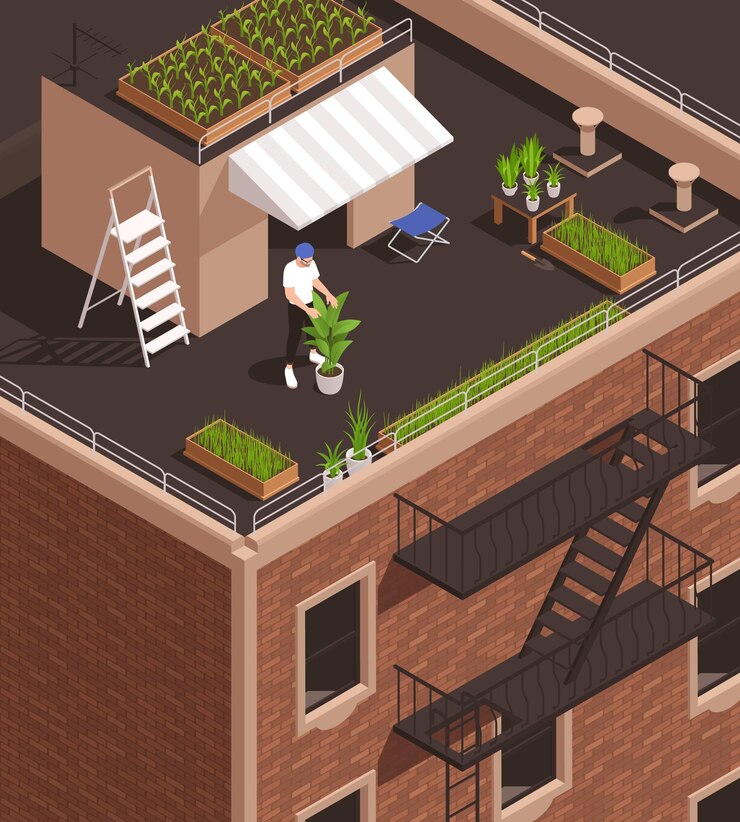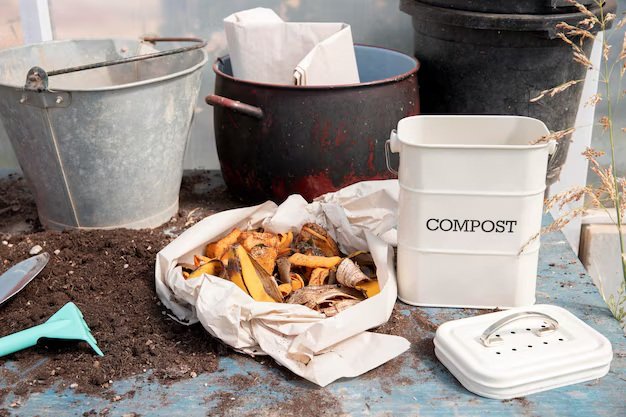7 Expert Tips for Building a Sustainable Roof Garden in Urban Areas
You will hardly find gardens in densely populated cities, but that doesn’t mean they don’t exist. The little available space in cities is often utilised and converted into gardens, especially on rooftops. Growing fresh fruits, vegetables, and beautiful flowers on rooftops not only enhances the aesthetic appeal of a building’s exterior but also provides fresh produce and offers numerous environmental benefits.
New York, London, and Singapore are among the major cities leading the way in transforming urban skylines with rooftop gardens. These gardens provide greenery to reduce urban heat and create habitats for pollinators. According to a 2020 study, rooftop gardens can significantly lower a city’s overall temperature, effectively combating the urban heat island effect.
Examples of iconic rooftop gardens include the High Line Park in New York, the Kensington Roof Garden in London, and the Gardens by the Bay in Singapore. If you aspire to own a sustainable rooftop oasis, a few expert-backed tips can help you create your ideal gardening space.

In This Article
- What Is a Rooftop Garden?
- How to Build a Sustainable Roof Garden in Urban Areas
- Future-Proofing Your Rooftop Garden
- Conclusion
What Is a Rooftop Garden?
A rooftop garden is a creative space filled with greenery, providing a solution to the lack of ground space in urban environments. Setting up a rooftop garden involves transforming available rooftop spaces of commercial or residential buildings into flourishing gardens. These spaces are utilised to grow fresh fruits, vegetables, and flowering plants.
Rooftop gardens within cities offer much more to urban dwellers. These green spaces are known to improve air quality, especially in cities with poor air quality. They provide a peaceful, green retreat that brings people closer to nature. Rooftop gardens typically fall into two main categories: extensive and intensive. Extensive gardens include small plants, shrubs, and herbs, while intensive gardens can support small trees and heavier plants.
Transforming rooftops into sustainable gardens requires more than just selecting plants. To set up a sustainable, high-rise garden, it’s essential to consider structural integrity, safety, environmental factors, and local building regulations. Here’s what you need to know.
How to Build a Sustainable Roof Garden in Urban Areas
1. Structural Integrity: The Foundation of a Successful Rooftop Garden
Before placing a single flower pot on any rooftop, ensure that the structure can support the weight of the plants and flowers you plan to set up. As plants grow, they require watering, which increases the weight of the soil. This is why we recommend consulting a structural engineer before transforming a rooftop space into a garden.
A professional assessment will determine if the roof you intend to garden on can support not only the initial weight of the garden but also the growing plants and the individuals using the space. Depending on the size of the garden and the types of plants you intend to grow, additional reinforcement may be necessary to ensure the structure is strong enough for a rooftop garden.
Case Study: Chelsea Market Roof Garden in New York City
Chelsea Market in New York City is home to one of the most famous rooftop gardens in the world. Before the rooftop became an iconic garden space, engineers had to thoroughly assess the building’s load-bearing capacity and reinforce parts of the structure. Today, Chelsea Market’s rooftop garden is a thriving spot, providing fresh produce for residents while maintaining its structural integrity.
Load-Bearing Capacity of Common Rooftop Gardens
| Building Type | Approximate Load-Bearing Capacity (kg/m²) | Example of Possible Vegetation |
| Commercial Buildings | 150-250 kg/m² | Herbs, Small Vegetables |
| Residential Buildings | 250-400 kg/m² | Larger Shrubs, Small Trees |
| Reinforced Roofs | 400-600 kg/m² | Full Vegetable Gardens, Small Trees |
Expert Insight
Dr William Scott, a civil engineer specializing in green buildings, advises that “structural integrity should never be underestimated when designing a rooftop garden. Even a small shift in weight can affect a building’s balance, especially in areas prone to seismic activity.” Dr Scott suggests always erring on the side of caution and reinforcing rooftops where necessary to accommodate the weight of soil, water, and plants.

Learn More: 10 Benefits of Gardening to the Environment and Why You Should Get Involved
2. Rooftop Garden Safety: Prioritising Safety in Design and Layout
Safety remains a top priority in any rooftop garden project. The purpose of creating a rooftop garden is to grow fresh food and beautiful flowering plants. Prioritising safety means avoiding actions that could lead to accidents, such as placing pots or gardening materials near the edge of the roof. Ensure that pots, especially those near ledges, are securely fastened, and consider adding railings around the perimeter of your rooftop garden.
Rooftop safety standards vary by location, so be sure to consult your local building codes for specific regulations on rooftop barriers.
Expert Tip: Wind Resistance and Protection
According to horticulturist Laura Mitchell, “Wind can be a major issue on rooftops. We recommend adding natural windbreaks using taller plants or installing lattice screens. This not only provides protection but also helps create micro-environments within the garden, which can be beneficial for more fragile plants.”
3. Environmental Considerations: Creating a Microclimate on the Rooftop
Rooftop gardens are more exposed to wind and sunlight due to their elevated positions. Setting up these high-rising green spaces requires proper planning. Without it, strong winds and sun exposure can quickly dry out plants, leading to lower crop yields. This is why assessing the environment before transforming a rooftop space into a garden is very important.
Wind and Sun Exposure
Plants in rooftop gardens are subjected to stronger winds and more intense sunlight. Not all plants will thrive in these conditions, so it’s important to choose hardy plants that can withstand strong winds and direct sunlight. For example, Mediterranean herbs such as rosemary and thyme are ideal for rooftop gardens.
However, you can use shade structures like pergolas or plant taller species around the edges of your garden to protect more sensitive plants from excessive sunlight.
Role of Pollinators
Rooftop gardens can serve as breeding grounds for pollinators like bees and butterflies, according to a 2022 study by the University of Cambridge. These beneficial insects will thrive in these green rooftop spaces, helping to rebuild their populations, which are rapidly declining in urban environments.”
Native Plants for Rooftop Gardens
- Lavender: Attracts bees and butterflies, drought-tolerant.
- Coneflowers: Native to North America, support pollinators.
- Milkweed: Essential for monarch butterflies.
Expert Insight: Urban Biodiversity
A 2019 study by the University of Sheffield discovered that urban rooftop gardens could serve as significant habitats for pollinators. According to Professor Duncan Cameron, ‘Rooftop gardens have the potential to transform city environments into biodiversity hotspots, creating safe havens for species threatened by urban development.'”
4. Waterproofing and Drainage: Preventing Water Damage and Promoting Sustainability
A well-planned rooftop garden must include a reliable waterproofing and drainage system. Without this system, water can seep through and damage the building’s structure. Installing high-quality waterproof membranes and layers on rooftops will prevent water from penetrating the roof.
An effective drainage system is also crucial to prevent rainwater or irrigation water from accumulating on the rooftop. The drainage system should be designed to avoid pooling. Raised planters and containers with drainage holes are effective gardening tools that help ensure water doesn’t accumulate around your plants’ roots.
Sustainable Watering Solutions
Installing rainwater collection systems or using drip irrigation ensures efficient water use. Drip irrigation systems are ideal for rooftop gardens, as they supply water directly to the plant’s roots, minimising the chances of evaporation and runoff.
Case Study: Green Roofs in Portland, Oregon
In Portland, Oregon, green roofs have been implemented with waterproofing and drainage systems that collect and reuse stormwater. The introduction of these sustainable water collection systems has helped prevent city-wide flooding and reduced the overall demand for municipal water systems.
Learn More: Eco-Friendly Initiatives in Small-Scale Urban Farming
5. Choosing Your Growing Method
There are several growing methods to choose from once you are ready to set up your rooftop garden. Some of the most common options include raised beds, vertical gardening, and container gardening. Each growing method has its pros and cons.
Growing Methods Comparison Table:
| Growing Method | Space Efficiency | Weight Considerations | Best for… |
| Container Gardening | High | Lightweight | Herbs, Small Vegetables |
| Raised Beds | Moderate | Medium-Heavy | Vegetables, Small Trees |
| Vertical Gardening | Very High | Lightweight | Vines, Climbing Plants |
Future-Proofing Your Rooftop Garden
Adapting to Climate Change
Climate change disrupts food production globally, causing long-lasting droughts and floods due to heavy rainfall. These extreme events can damage crops and reduce yields in ground-level gardens. Rooftop gardens face similar challenges, as the increasing frequency of extreme weather events can stress plants and lead to lower crop yields. To future-proof your rooftop garden, consider adding drought-resistant species to your green space. Popular options include sedums and succulents, which are capable of storing water in their leaves and are highly drought-tolerant.
Smart Irrigation and Monitoring Systems
Incorporating smart technology into a rooftop garden can help future-proof it. Invest in smart irrigation systems that use sensors to monitor soil moisture levels. These technologically advanced systems can automatically adjust the watering schedule based on weather conditions, ensuring water is conserved while plants receive the hydration they need to flourish on rooftops.
Conclusion
Unlike ground-level gardens, rooftop garden projects require careful planning with the consultation and supervision of a structural engineer. A professional assessment is necessary to determine if the roof where you intend to set up a garden can support not only the garden’s weight but also the weight of the plants as they grow, as well as the weight of individuals who will be using the space.
Safety remains a top priority in any rooftop garden project. By following the steps outlined above—ensuring structural integrity, prioritising safety, selecting the right plants, and incorporating innovative technologies—you will be well on your way to setting up a rooftop garden that thrives for years. Whether you’re looking to reduce your carbon footprint, grow your own food, or simply create a beautiful space to relax, rooftop gardens offer endless possibilities for urban sustainability.
As cities continue to expand, green spaces like rooftop gardens will become increasingly essential. Not only do they provide ecological benefits by reducing urban heat and supporting pollinators, but they also offer a retreat from the stresses of city life. With careful planning and a commitment to sustainability, your rooftop garden can become a model for others, contributing to a greener, healthier planet.







